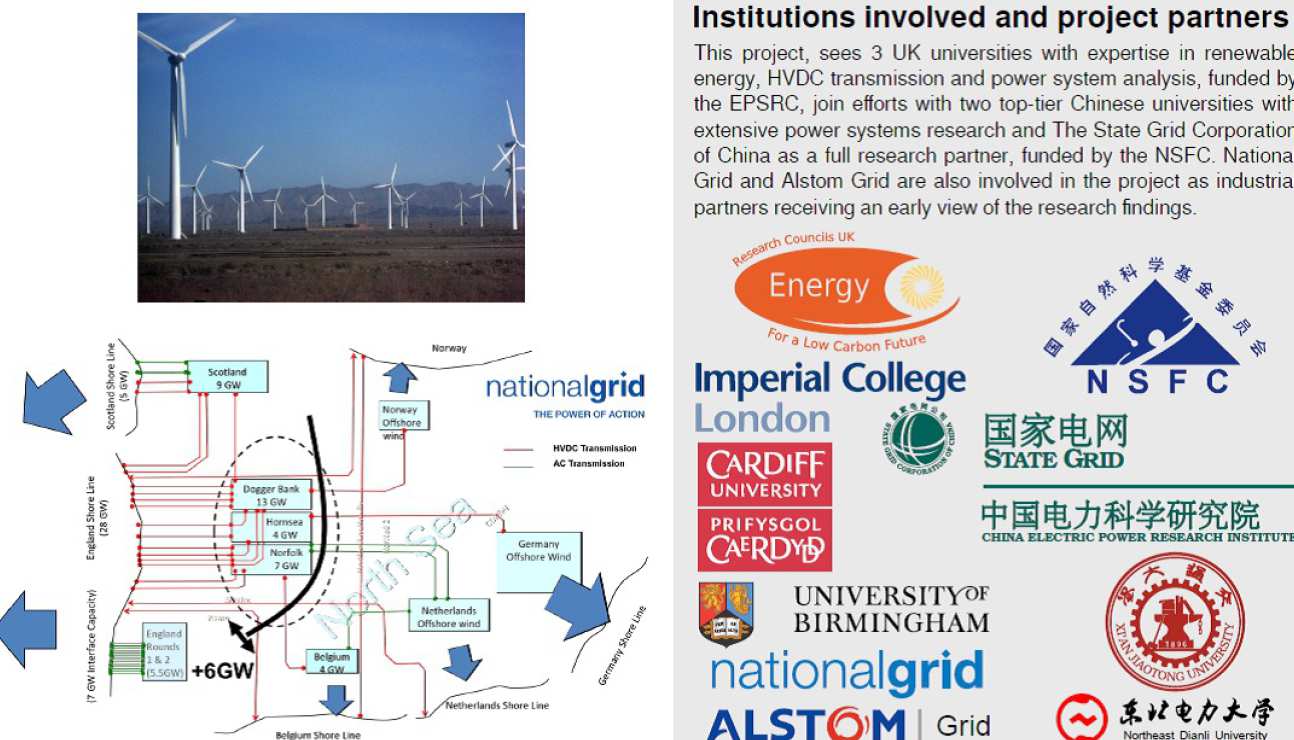Enhanced Renewable Integration through Flexible Transmission Options (ERIFT)
 This project sees 3 UK universities (Imperial College London, Cardiff University and University of Birmingham) with expertise in renewable energy, HVDC design & control and power system analysis join efforts with two top-tier Chinese universities with extensive power systems research and The State Grid Corporation of China as a full research partner. Their individual research track records are now briefly described.
This project sees 3 UK universities (Imperial College London, Cardiff University and University of Birmingham) with expertise in renewable energy, HVDC design & control and power system analysis join efforts with two top-tier Chinese universities with extensive power systems research and The State Grid Corporation of China as a full research partner. Their individual research track records are now briefly described.
China is installing wind farms faster than any other nation and the UK is leading deployment of offshore wind farms. Both nations will face challenges in connecting renewable sources in remote areas over (electrically) long cable or overhead DC routes and also challenges in controlling a system with a high proportion of asynchronous generation. This proposal identifies areas of common technical challenge and lays out a joint programme to analyse the issues and assess possible solutions.
Fully exploiting the potential transfer capacity is vital; in China this is from western/central hydro resources to eastern/costal cities and in the UK from Scottish and North Sea wind resource to southern load centres. The realisable transfer capacity from a set of AC and DC routes depends on exactly how the control of the system is arranged under different loading conditions (which affects stability constraints) and on the risk profile of the configuration (which affects the de-loading for redundancy and security reasons). We will investigate coordinated control of AC, DC and FACTS elements to optimise transfer capacity and will develop tools to support operator decision-making including risk analysis. A national transmission system run with a high proportion of asynchronous generation has little inertia and so explicit frequency response needs to be synthesised to maintain the system frequency within limits. Two specific aspects will be investigated: the ability to provide frequency response services across a DC link (from kinetic energy from wind turbines at the remote end) without explicit communication of frequency data and the headroom required in power converters (turbine and HVDC) to accommodate this service. The protection schemes that identify and isolated faulty equipment are also impacted by use of asynchronous generation since their power converter interfaces offer much lower short-circuit currents that are difficult to discriminate. The problem will be analysed in detail and re-engineering of the protection schemes proposed.
A series of technical challenges that arise from widespread use of HVDC to connect remote renewable resources will also be studied. First is the operation and protection of multi-terminal HVDC that would allow meshing of DC routes to form more secure networks providing that the power flow and fault management issues can be addressed. Second is the reassessment of wind farm collection networks to eliminate potentially wasteful energy conversion stages. Third is innovation in HVDC converter design to make cost-effective the supply (or in-feed) of small fractions of power at intermediate points.
The key outputs will be the analysis methods that are developed to assess the problems identified (and which are useful to grid system operators); proposals for engineering solutions (useful to system operators and equipment vendors) and verification of these proposals through scaled laboratory test systems and real-time simulation.
CAP people
- Tim C Green, tcg@imperial.ac.uk
- Balarko Chaudhuri, b.chaudhuri@imperial.ac.uk
- Xiaotian Zhang, xzhang4@imperial.ac.uk
- Adria Junyent Ferre, adria.junyent-ferre@imperial.ac.uk
- Yousef Pipelzadeh, y.pipelzadeh08@imperial.ac.uk


